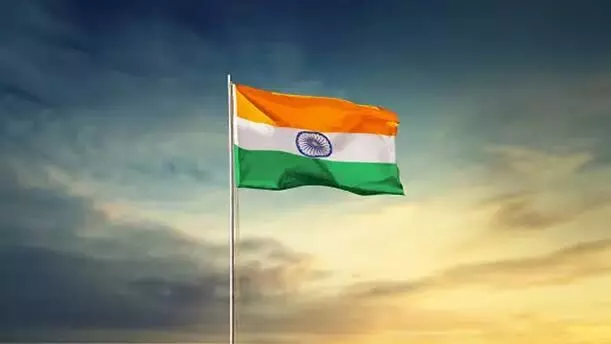Tiranga: From khadi’s soul to polyester’s shadow
Few remember Pingali Venkayya, the visionary Telugu man who conceptualised India’s national flag
By B.V.Seshagiri Advocate
Tiranga: From khadi’s soul to polyester’s shadow
Hyderabad: The Khadi Legacy: Indian tricolour was not just a symbol; it was a statement. Born out of the Swadeshi movement and sanctified by the freedom struggle, the Tiranga was, for decades, made only in khadi, hand-spun and hand-woven in wool, cotton, or silk. The Flag Code of India, until 30 December 2021, mandated that no machines fabrics be used, no synthetics be woven in. The yarn itself was steeped in the ideals of self-reliance.
The Man behind the Flag:
Few remember Pingali Venkayya, the visionary Telugu man who conceptualised India’s national flag. A polymath—farmer, geologist, educationist, and freedom fighter—Venkayya presented his design to Mahatma Gandhi in 1921. Over time, it evolved into the tricolour we know today, with saffron, white, green, and the Ashoka Chakra.
Freedom Struggle and Swadeshi:
Khadi flags were not mere decorations; they were political weapons. Under British rule, possessing or hoisting the national flag could lead to imprisonment. Freedom fighters stitched them in secrecy, raised them in defiance, and marched under them into lathi charges. Khadi was chosen deliberately—it was India’s answer to British textiles, a living embodiment of self-reliance, dignity, and resistance.
The Polyester Turn:
On 30 December 2021, the Government of India amended the Flag Code, allowing machine-made polyester flags. The decision was justified on grounds of durability and year-round availability, especially for large-scale hoisting, which now rolls out of power looms and arrives in shipping containers. Some of these flags are even imported.
The Tallest Flag Race:
Across the country, a new obsession has taken root: the race to install the tallest 24x7 hoisted flagpoles. Cities and towns vie for records, with flag heights surpassing 300 feet. The flags used for these massive poles are usually polyester, chosen because khadi cannot withstand high winds for long periods.
“In the freedom struggle, the flag was the protest. Today, it risks becoming just the prop”.
Sanctity and the Law:
The Prevention of Insults to National Honour Act, 1971, prescribes penalties for disrespecting the flag. The Flag Code specifies its proportions—3:2 length to heightand dictates that saffron must always be at the top when flown. Hoisting it upside down or allowing it to touch the ground is considered an offence; the Tiranga should be unfurled only from sunrise to sunset, regardless of weather. Khadi was, for decades, part of this sanctity—not merely as a fabric, but as the moral fibre of the nation.
Why Polyester Dilutes the Sanctity:
Polyester is lifeless, industrial, and born of fossil fuels—its threads carry no human touch. Khadi, by contrast, is hand-spun, eco-friendly, and rooted in the self-reliance that powered our freedom struggle. To replace khadi with polyester in the Tiranga is not just changing fabric; it is exchanging a sacred symbol of sacrifice, dignity, and heritage for a mass-produced imitation, eroding the very soul it represents.
A Call to Conscience:
The Tiranga is not mere fabric; it is the living testament of our freedom struggle. To weave it in synthetic threads, sometimes in distant foreign mills, is to strip it of the soul that the charkha once spun into every strand. A nation that crafted its identity in the humble, hand-spun yarn of sacrifice must pause before letting that sacred spirit dissolve into the cold uniformity of polyester.
The Tiranga is not merely a flag but the living embodiment of India’s freedom struggle, woven in khadi with the sweat and spirit of a self-reliant nation. From the vision to its role in the Swadeshi movement, it has carried the weight of sacrifice, unity, and dignity. The shift to machine-made polyester, even imported versions, risks severing that sacred connection between the symbol and its story. To preserve its sanctity, the flag must remain more than fabric; it must continue to represent the ideals and conscience of the nation it unfurls over.
The Tiranga is the story of who we are and where we come from. Each Khadi thread once carried the touch of an artisan, the hope of a village, and the memory of a movement that refused to bow. If we now let its weave be replaced by lifeless synthetic fibres, spun far from the spirit of the charkha, we risk draining away the sanctity that has sustained its meaning.
This is not merely a question of convenience or cost—it is a question of conscience. What legacy will we pass on to the generations yet unborn? Will they inherit a flag that feels like the hands that spun it, or one that feels like it came off an assembly line? The answer will not be written in law or policy, but in the hearts of the people. And when we raise the Tiranga to the sky, we must ask ourselves: are we saluting a piece of fabric, or the soul of our nation?
A Citizen’s Note:
This piece is written from the heart, as one Indian speaking to another, to reflect on what our Tiranga means to us. It is not meant to attack, accuse, or target any individual, group, or government, but to invite dialogue and reflection. The thoughts expressed are personal convictions, rooted in love for our country and its ideals, the freedom struggle, and history, and offered in the hope that we guard the dignity of our national symbols with the same devotion that won us our freedom. For if we lose the spirit woven into our Tiranga, no law, no material, no ceremony can restore it.
(B.V. Seshagiri is a practicing advocate and socio-political activist, a law graduate, and holds an Advanced Post Graduate Diploma in Criminal Law and Forensic Science from NALSAR University of Law, Shamirpet, Hyderabad.)